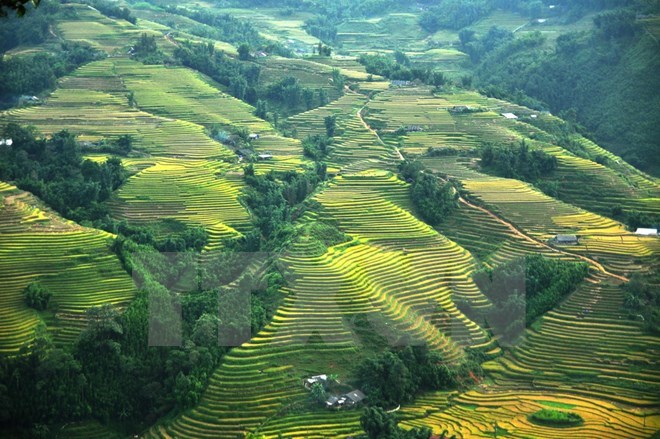



Terrace fields in Sa Pa (Photo VNA)
Homestay services in Ta Van, Lao Chai
and Ta Phin have recently been packed with domestic and foreign holidaymakers
who love to learn about the daily life of local residents through eating,
living and working with them.
Located in Muong Hoa valley, at the foot of Hoang Lien Son mountain range, Ta
Van commune impresses tourists at first sight by spectacular natural scenery
with terrace fields, high mountains, and traditional houses.
Patrick O’Regan from New Zealand shared that he knows Sa Pa through his friends
who traveled there and had a lot of compliments on the nature as well as the
unique culture of Vietnam.
That was the reason why he and his family chose a homestay tour in a rural area
in Sa Pa to explore the local culture and customs, he said.
Dev Dervesh, a tourist from India, said he enjoyed very much the stay at The
Little H’Mong House at Ta Van’s Giang Ta Chai Mong village. He planned to stay
longer in Sa Pa during his trip to Vietnam.
Bui Thi Oanh, owner of The Little
H’Mong House, said her traditional wood house, which can accommodate 30 guests,
was filled during the first several days of 2018.
Several companies have invested in
facilities after the homestay model with a modern note. Director of
Vietdiscovery Co., Ltd. Do Trong Nguyen said the company’s La Dao Spa Ta Van
facility offers homestay services plus several extra treats such as herbal bath
of Dao people and traditional dishes of Mong and Giay ethnic people.
Le Manh Hao, Vice Chairman of the Sa Pa People’s Committee, said the district
is home to nearly 500 accommodations with 6,000 rooms, including 154 homestay
facilities in Ta Van, Lao Chai, Hau Thao, Nam Sai, Ta Phin, Ban Ho, Thanh Phu
and Thanh Kim communes with 2,800 beds.
The district is focusing on community-based tourism development to increase
incomes for locals and preserve traditional cultural values, he added.
Located 350km northwest of Hanoi capital city, Sa Pa is 1,600m high above sea
level, with the average temperature of 15-18°C. The whole town is dominated by
the Hoang Lien Son mountain range which is famous with the Indochina’s highest
mountain of Fansipan at a height of 3,142 m above sea level.
Discovered in 1903 by the French, Sa Pa has many natural scenic sites such as
Ham Rong Mountain, Thac Bac (Silver Waterfall), Cau May (Rattan Bridge), Bamboo
Forest and Ta Phin Cave. The hill town is home to six main ethnic minority
groups, including Kinh, Hmong, Dao, Tay, Day and Xa Pho with various
traditional festivals and unique cultural practices, especially the Bac Ha
market and Sa Pa love market.
The resort town of Sa Pa was recognised as a national tourism site in December
2017.
Source: VNA